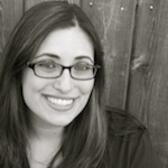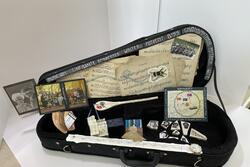Why, on this night, do we include women's voices?
People share their ways of including women's voices at Passover in JWA's Facebook poll.
In collaboration with JewishBoston.com, JWA are putting the finishing touches on a new Haggadah that highlights women's voices. (Keep an eye out for it next week.) As we've been thinking about seders and traditions and the different ways we could include women's voices in the Haggadah we're creating, I wanted to hear more from you about your traditions and how you include women's voices.
This week I posted a Facebook poll asking people to share how they include women in their seders. Originally, I put three options to choose form: Miriam's Cup, an orange on the seder plate, and singing Debbie Friedman's Miriam's Song. Over the week, people have taken the poll and shared it with their friends. They also added seven more ways to feature women's voices.
So far, the most popular way to include women is Miriam's Cup with 33 votes. In next place is putting an orange on the seder plate with 20 votes. Seventeen women lead their own seder, and 14 use commentaries by women. Twelve votes for singing Debbie Friedman's Miriam's Song, three votes for using a women's haggadah, two votes for emphasizing the roles of women in earning redemption from Egypt, one vote for giving a Shifra and Puah award, and of course, one person voted for "None." (Ten points for being honest.) People could vote for more than one at a time, and it was pretty common for folks to choose two or three ways they include women's voices at their seder. Pretty cool. The poll is still open, cast your vote!
I was curious about the Shifra and Puah award, something I had not yet heard of. Shifra and Puah were two midwives who defied Pharoah's order to murder all Hebrew male babies born in Egypt. These women are important figures, perhaps responsible for beginning the cycle of protest against Pharoah that led to the Exodus. Visit jwa.org to learn more about Shifra and Puah's role, and the stories of American Jewish women who practiced midwifery at the turn of the 20th Century.
I contacted the person who added the Shifra and Puah award and learned that it was given at Brandeis Hillel in the late '70s during the height of the Soviet Jewry movement. The Shifra and Puah award was given to someone who had taken a risk and engaged in civil disobedience to fight injustice.
I love this idea and am excited to incorporate it into my seder tradition. It's always exciting to learn about new Passover traditions and I hope you will add yours to our Facebook poll, or share them in the comments.








There is a midrashic tradition that the midwife Puah was actually Miriam herself, sister of Moses, in disguise. The name Puah means "lifting up of one's face" particularly in defiance of an unjust edict or gezera. The midrash considers that Miriam already bravely challenged the status quo when she convinces her father to resume marital relations with his wife in defiance of Pharaoh's genocidal edict. She again takes up anti-gezera action as a midwife. Avivah Zornberg has a lot to say about women's anti-gezera brigade as founded by Miriam-Puah in her book Particulars of Rapture.It is a provocative attitude that forever challenges inertia, stagnation, and despair. ( I have written about this on my own blog at http:susanrtorn.wordpress.com/... At my seder, I invite everyone to think of a time when she/he took such a stance. This commemoration of our leaving "mitzra'im" or the constriction of Egypt and moving to a much broader place is also a great time to consider the broader repertory of choice we all now have in our daily actions.
We Remember Idit
When we read the shefoch chamatcha passage of the haggadah, we ask that G-d deliver wrath on the nations that have tried to destroy us. LotÌ¢âÂã¢s wife, Idit, who turned back to see the town of Sodom as it was being destroyed, witnessed the outpouring of such divine anger. In the reading below, Sandy Sasso brings Idit and her wisdom to this part of the Seder ritual. We place a container of salt next to ElijahÌ¢âÂã¢s and MiriamÌ¢âÂã¢s Cups in remembrance of Idit. As we open the door again, to invite Idit to our Seder, we lift the container of salt and say: We remember IditÌ¢âÂÛonce known only as LotÌ¢âÂã¢s wifeÌ¢âÂÛ who wept at the destruction of her enemies. This is the salt of her tears. Ì¢âÂÒOur eyes run with tears, Our pupils flow with waterÌ¢âÂå (Jeremiah (;17) We remember IditÌ¢âÂÛonce known only for her act of disobedienceÌ¢âÂÛ who turned out of compassion for life destroyed. This is the salt of her tears. Welcome, Idit, to our seder. Teach us deeds of lovingkindness. Hodu LaÌ¢âÂã¢adonay ki tov, kiÌ¢âÂã¢lÌ¢âÂã¢olam hasdo Give thanks to the Eternal who is good, whose lovingkindness endures forever. Yomar na yisrael, ki lÌ¢âÂã¢olam hasdo. Let all Israel say, G-dÌ¢âÂã¢s lovingkindness endures forever. Yomru na yirey adonay, ki lÌ¢âÂã¢olam hasdo. Let all in awe of G-d declare, G-dÌ¢âÂã¢s lovingkindness endures forever.Ì¢âÂå